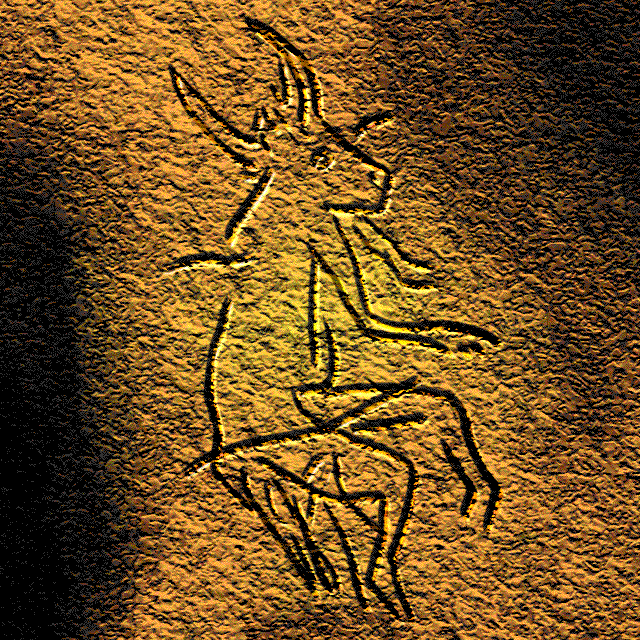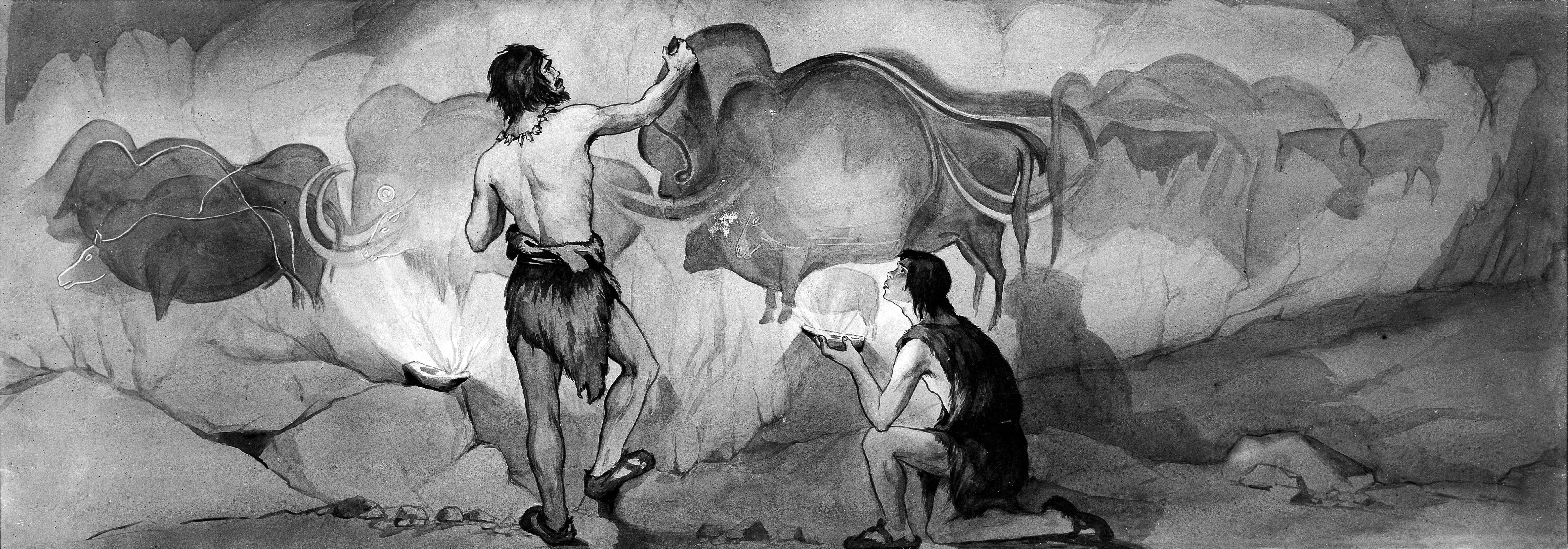|
Grotte De Gabillou
The Grotte de Gabillou also known as Grotte de las Agnelas is a cave in France in which prehistoric ornaments stemming from the Paleolithic period exist. It is situated in the commune of Sourzac in the department of Dordogne, Nouvelle Aquitaine and is a private property. Its sediments are from the Maastrichtian era. History The cave was discovered either in 1940 or in 1941 and subsequently its discovery was announced to the . It was classified as a historic monument on the 20 July 1942. In 1955, the property containing the cave was bought by Jean Gaussen, who in 1964 published a book about the ornaments in the cave which depict mostly animals but also some humans. Some of the caves artifacts were displayed during an exhibition in April 2017. The access in only possible through the basement below one room and research is restricted due to the fragile durability of the ornaments. As of 2015, only researchers with relevant qualifications are allowed to study the cave. Location ... [...More Info...] [...Related Items...] OR: [Wikipedia] [Google] [Baidu] |
Gabillou Sorcier
Gabillou (; ) is a Communes of France, commune in the Dordogne Departments of France, department in Nouvelle-Aquitaine in southwestern France. Population See also *Communes of the Dordogne department References Communes of Dordogne {{SarlatlaCanéda-geo-stub ... [...More Info...] [...Related Items...] OR: [Wikipedia] [Google] [Baidu] |
France
France, officially the French Republic, is a country located primarily in Western Europe. Overseas France, Its overseas regions and territories include French Guiana in South America, Saint Pierre and Miquelon in the Atlantic Ocean#North Atlantic, North Atlantic, the French West Indies, and List of islands of France, many islands in Oceania and the Indian Ocean, giving it Exclusive economic zone of France, one of the largest discontiguous exclusive economic zones in the world. Metropolitan France shares borders with Belgium and Luxembourg to the north; Germany to the northeast; Switzerland to the east; Italy and Monaco to the southeast; Andorra and Spain to the south; and a maritime border with the United Kingdom to the northwest. Its metropolitan area extends from the Rhine to the Atlantic Ocean and from the Mediterranean Sea to the English Channel and the North Sea. Its Regions of France, eighteen integral regions—five of which are overseas—span a combined area of and hav ... [...More Info...] [...Related Items...] OR: [Wikipedia] [Google] [Baidu] |
Paleolithic Period
The Paleolithic or Palaeolithic ( years ago) ( ), also called the Old Stone Age (), is a period in human prehistory that is distinguished by the original development of stone tools, and which represents almost the entire period of human prehistoric technology. It extends from the earliest known use of stone tools by hominins, 3.3 million years ago, to the end of the Pleistocene, 11,650 cal BP. The Paleolithic Age in Europe preceded the Mesolithic Age, although the date of the transition varies geographically by several thousand years. During the Paleolithic Age, hominins grouped together in small societies such as bands and subsisted by gathering plants, fishing, and hunting or scavenging wild animals. The Paleolithic Age is characterized by the use of knapped stone tools, although at the time humans also used wood and bone tools. Other organic commodities were adapted for use as tools, including leather and vegetable fibers; however, due to rapid decompositio ... [...More Info...] [...Related Items...] OR: [Wikipedia] [Google] [Baidu] |
Communes Of France
A () is a level of administrative divisions of France, administrative division in the France, French Republic. French are analogous to civil townships and incorporated municipality, municipalities in Canada and the United States; ' in Germany; ' in Italy; ' in Spain; or civil parishes in the United Kingdom. are based on historical geographic communities or villages and are vested with significant powers to manage the populations and land of the geographic area covered. The are the fourth-level administrative divisions of France. vary widely in size and area, from large sprawling cities with millions of inhabitants like Paris, to small hamlet (place), hamlets with only a handful of inhabitants. typically are based on pre-existing villages and facilitate local governance. All have names, but not all named geographic areas or groups of people residing together are ( or ), the difference residing in the lack of administrative powers. Except for the Municipal arrondissem ... [...More Info...] [...Related Items...] OR: [Wikipedia] [Google] [Baidu] |
Sourzac
Sourzac (; ) is a commune in the Dordogne department in Nouvelle-Aquitaine in southwestern France. Population International relations Twinned with Vigy since 1991. See also *Communes of the Dordogne département The following is a list of the 503 communes of the Dordogne department of France. The communes cooperate in the following intercommunalities (as of 2025):Communes of Dordogne {{Périgueux-geo-stub ... [...More Info...] [...Related Items...] OR: [Wikipedia] [Google] [Baidu] |
Dordogne
Dordogne ( , or ; ; ) is a large rural departments of France, department in south west France, with its Prefectures in France, prefecture in Périgueux. Located in the Nouvelle-Aquitaine region roughly half-way between the Loire Valley and the Pyrenees, it is named after the river Dordogne (river), Dordogne, which runs through it. It corresponds roughly to the ancient county of Périgord. In January 2023, Dordogne had a population of 412,807. History The county of Périgord dates back to when the area was inhabited by ancient celtic Gauls, Gaulish tribes. It was originally home to four tribes, and since "four tribes" in the Gaulish language is "Petrocore", the area eventually became known as the county of Le Périgord. Its inhabitants became known as the Périgordins (or Périgourdins), and there are four Périgords in the Dordogne. * Périgord Vert (Green Périgord), with its main town of Nontron, consists of verdant valleys in a region crossed by many rivers and streams ... [...More Info...] [...Related Items...] OR: [Wikipedia] [Google] [Baidu] |
Nouvelle-Aquitaine
Nouvelle-Aquitaine () is the largest Regions of France, administrative region in France by area, spanning the west and southwest of Metropolitan France. The region was created in 2014 by the merging of Aquitaine, Limousin, and Poitou-Charentes in a territorial reform. Nouvelle-Aquitaine has an area of – more than of Metropolitan France – and has a population of 6,033,952 . The new region was established on 1 January 2016, following the 2015 French regional elections, regional elections in December 2015. It is the largest region in France by area (including Overseas departments and regions of France, overseas regions such as French Guiana), with a territory slightly larger than that of Austria. Its Prefectures in France, prefecture and largest city, Bordeaux, together with its suburbs and satellite cities, forms the seventh-largest metropolitan area of France, with 850,000 inhabitants. The region has 25 major urban areas, among which the most important after Bordeaux are B ... [...More Info...] [...Related Items...] OR: [Wikipedia] [Google] [Baidu] |
Sediment
Sediment is a solid material that is transported to a new location where it is deposited. It occurs naturally and, through the processes of weathering and erosion, is broken down and subsequently sediment transport, transported by the action of wind, water, or ice or by the force of gravity acting on the particles. For example, sand and silt can be carried in suspension (chemistry), suspension in river water and on reaching the sea bed deposited by sedimentation; if buried, they may eventually become sandstone and siltstone (sedimentary rocks) through lithification. Sediments are most often transported by water (fluvial, fluvial processes), but also wind (aeolian processes) and glaciers. Beach sands and stream channel, river channel deposits are examples of fluvial transport and deposition (geology), deposition, though sediment also often settles out of slow-moving or standing water in lakes and oceans. Desert sand dunes and loess are examples of aeolian transport and deposition. ... [...More Info...] [...Related Items...] OR: [Wikipedia] [Google] [Baidu] |
Maastrichtian
The Maastrichtian ( ) is, in the International Commission on Stratigraphy (ICS) geologic timescale, the latest age (geology), age (uppermost stage (stratigraphy), stage) of the Late Cretaceous epoch (geology), Epoch or Upper Cretaceous series (stratigraphy), Series, the Cretaceous geologic period, Period or system (stratigraphy), System, and of the Mesozoic geologic era, Era or Erathem. It spanned the interval from . The Maastrichtian was preceded by the Campanian and succeeded by the Danian (part of the Paleogene and Paleocene). It is named after the city of Maastricht, the capital and largest city of the Limburg (Netherlands), Limburg province in the Netherlands. The Cretaceous–Paleogene extinction event (formerly known as the Cretaceous–Tertiary period, Tertiary extinction event) occurred at the end of this age. In this extinction event, mass extinction, many commonly recognized groups such as non-avian dinosaurs, plesiosaurs and mosasaurs, as well as many other lesser-kn ... [...More Info...] [...Related Items...] OR: [Wikipedia] [Google] [Baidu] |
Isle (river)
The Isle (; ) is a long river in south-western France, right tributary of the Dordogne. Its source is in the north-western Massif Central, near the town Nexon (south of Limoges). It flows south-west through the following ''départements'' and towns: * Haute-Vienne: Le Chalard * Dordogne: Périgueux, Mussidan * Gironde: Libourne It flows into the Dordogne in Libourne Libourne (; ) is a commune in the Gironde department in Nouvelle-Aquitaine in southwestern France. It is a sub-prefecture of the department. It is the wine-making capital of northern Gironde and lies near Saint-Émilion and Pomerol. Geog .... Among the tributaries of the Isle are the Auvézère, the Loue, the Beauronne and the Dronne. References Rivers of France Rivers of Dordogne Rivers of Gironde Rivers of Haute-Vienne Rivers of Nouvelle-Aquitaine Nouvelle-Aquitaine region articles needing translation from French Wikipedia {{France-river-stub ... [...More Info...] [...Related Items...] OR: [Wikipedia] [Google] [Baidu] |
Mussidan
Mussidan (; ) is a commune in the Dordogne department in Nouvelle-Aquitaine in southwestern France. Mussidan station has rail connections to Bordeaux, Périgueux, Brive-la-Gaillarde and Limoges. Population Roundup of 16 January 1944 On 16 January 1944, 35 hostages were arrested by the Germans for acts of resistance. They were deported to German work camps.. Battle and executions of 11 June 1944 On 11 June 1944 Francs-Tireurs et Partisans destroyed a German armoured train at Mussidan station. During the fight, eight guerrillas and the train guard were killed. At the same time a convoy of the 11th Panzer Division of the Wehrmacht arrived from Bordeaux. The guerrillas were obliged to withdraw. As a reprisal, a detachment of the Gestapo from Périgueux led by Second Lieutenant Michaël Hambrecht, reinforced by a platoon led by Alexandre Villaplane, head of one of the five sections of the North African Brigade and former captain of the France football team at the 1930 Worl ... [...More Info...] [...Related Items...] OR: [Wikipedia] [Google] [Baidu] |
Magdalenian
Magdalenian cultures (also Madelenian; ) are later cultures of the Upper Paleolithic and Mesolithic in western Europe. They date from around 17,000 to 12,000 years before present. It is named after the type site of Abri de la Madeleine, a rock shelter () located in the Vézère valley of Tursac in Dordogne, France. Édouard Lartet and Henry Christy originally termed the period ''L'âge du renne'' "the age of the reindeer". They conducted the first archaeological excavation of the type site, publishing in 1875. The Magdalenian is associated with reindeer hunters. Magdalenian sites contain extensive evidence for the hunting of red deer, wild horses, and other megafauna present in Europe toward the end of the Last Glacial Period. The culture was geographically widespread, and later Magdalenian sites stretched from Portugal in the west to Poland in the east, and as far north as France, the Channel Islands, England, and Wales. Besides la Madeleine, the chief stations of the Ma ... [...More Info...] [...Related Items...] OR: [Wikipedia] [Google] [Baidu] |






